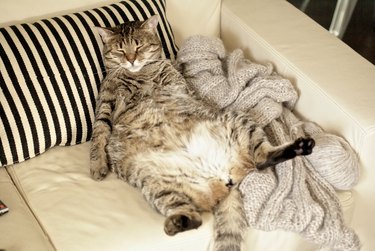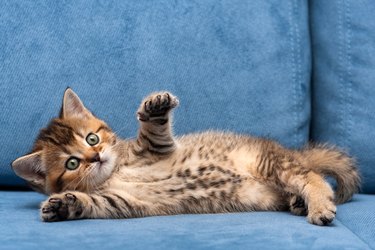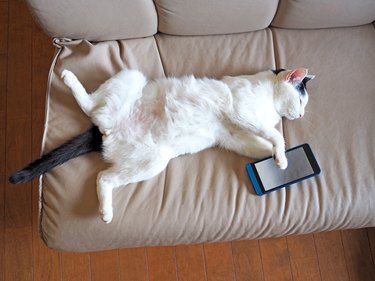Dr. Ingrid Taylor, a veterinarian with 16 years of experience in general clinical and emergency practice and public health, says, yes, cats do have a belly button! Most pet parents are surprised to discover that their cat has a belly button. After all, they spend hours grooming their kitty's coat and doling out belly rubs without ever seeing a trace of a belly button. However, your cat does indeed have one. You just need to know what a cat's belly button looks like and how to find it.

Video of the Day
The belly button is the colloquial term for the navel or umbilicus, and all placental mammals, including cats, have one. The belly button is where the umbilical cord attaches during natal development.
Video of the Day
The umbilical cord is vital, as it carries nutrition and oxygen from the mother to the kitten inside the womb in addition to taking waste products and carbon dioxide from the fetus to the mother. Once her kittens are born, the mother cat licks the umbilical cord until it detaches from the placenta. "The area where the umbilical cord was connected closes up, leaving a small scar that is the feline equivalent to a human's belly button," says Dr. Taylor.

Cat owners often have trouble finding their cat's belly button because people are typically looking for a navel that resembles their own. In fact, a cat's belly button looks nothing like the innie and outie belly buttons sported by humans. "A cat's belly button is flush against their skin and looks like a small, thin, circular scar," explains Dr. Taylor. "It's around 5 millimeters in circumference and is typically found about midway down the abdomen, just below the rib cage and between the nipples.
They can be difficult to find because they're often obscured from view by the cat's fur, especially in long-hair cat breeds. However, fur won't usually grow on top of a cat's navel, which causes people to think it's a bald patch rather than a belly button.

Your cat is most likely not hiding their belly button from you. Primarily because of the language barrier between humans and felines, your cat is unaware of any desire to see their belly button.
But also, when cats lay on their back exposing their tummy, they are expressing contentment, happiness, and willingness to play and cuddle. For the most part, cats are signaling trust and that they feel safe in your presence when on their back, meaning you are free to give them a belly rub and examine their navel. However, this is not always the case. So, explore at your own risk.
Umbilical hernias in cats
If your newborn kitten has something resembling an outie, it could actually be a swelling under their umbilicus or in the surrounding skin. This indicates they likely have an umbilical hernia. While it can be a common condition, umbilical hernias always warrant a visit to the veterinarian, who will diagnose the umbilical hernia and determine the best way to treat it. Even if it seems innocuous, all suspected hernias should be assessed by a veterinarian.
What causes hernias in cats?
"A hernia is caused by the umbilicus not closing properly, leaving an opening in the abdominal wall where the kitten's umbilical cord had been attached," explains Dr. Taylor. "It can appear as a soft swelling in the area of the umbilicus." However, a more serious case can occur where contents of the abdomen, including abdominal fat and intestines, can slip into this opening, causing a swelling under the skin.
Typically, umbilical hernias are hereditary, though trauma can also be a cause. "Small hernias may close on their own, but if they don't, surgery is required to repair them," says Dr. Taylor. "It's usually safe to wait to repair it until the cat is undergoing a spay or neuter. However, large and more serious hernias could need immediate attention and repair." Your veterinarian will determine how and when a hernia should be fixed.
A strangulated hernia is a medical emergency
"Strangulated hernias can become deadly," says Dr. Taylor. If intestines become trapped in the hernia, strangulation of the intestinal loops can occur, restricting blood vessels and thus blood flow to the intestine and potentially causing tissue damage and tissue death. Intestinal blockages are also possible. Strangulated hernias can become fatal in a cat.
Symptoms of a hernia in cats
Here are the symptoms to look for if you suspect your cat may have a strangulated hernia:
- a large, swollen, warm hernia
- sudden changes to the size of the hernia
- vomiting
- abdominal pain
- loss of appetite
- lethargy
- behavioral changes
If these signs are present, your cat needs emergency medical treatment. Your veterinarian may perform X-rays or an ultrasound to diagnose a strangulated hernia.

The bottom line
While your cat does have a belly button, it's not prominent and is often difficult to detect. During your next cuddle or grooming session, look for a small 5-millimeter scar near the base of your cat's ribs that resembles a bald patch. If your cat has puffiness surrounding their belly button, they may have an umbilical hernia. Consult your veterinarian, who will help you with a diagnosis and a course of treatment.